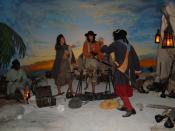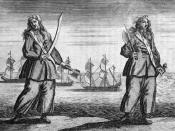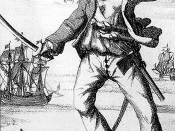Piracy, in international law, the crime or robbery, or other act of violence for private ends, on the high seas or in the air above the seas (Encarta 1). Piracy in the Caribbean was a tough life that was only for certain men. Yes, that's right, for men. Life as a pirate was very dangerous because of serious injury and even death. Pirates would frequently attack an enemy vessel by boarding the ship, robbing the goods, and quickly leaving. In most attacks, the pirates would be outnumbered causing a bloody attack (American 119). This is why the captain of their boats would not allow women to be pirates. If a woman wanted to be a pirate she would have to dress and act as though she was a man. That is why history recognizes the few pirates that were women. There were a couple of notorious women pirates in the Caribbean.
Two pirates in particular had extraordinary and exciting lives.
It all started from a brave lady named Lady Killigrew, married to Sir John Killigrow who was vice-admiral of Cornwall, England, and royal governor of Pendennis Castle. There had been pirates on both sides of the family (Rankim 417). In the 17th century, it was common for piracy to be allowed in authorities without too much commotion. Lady Killigrew decided to take part of the family tradition and went to several piratical cruises along the English coast with her spouse. Soon she became anxious for more excitement, and thus gathered her crew and attacked a German ship, which was anchored in Falmouth harbor, loaded with valuable cargo. Lady Killigrew
killed the crew on the ship and took two barrels of heavy silver. Later on Queen Elizabeth caught Lady Killigrew and tried her to be hanged along with two of her...



Nice piecce of work
That is definately a interesting reading. The author manages to hold the interest right from the start to the end. Congrats!
2 out of 2 people found this comment useful.